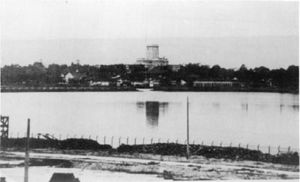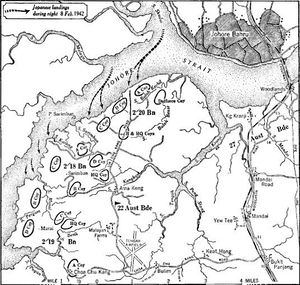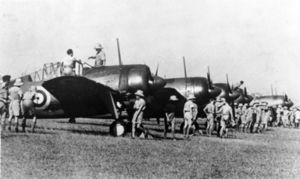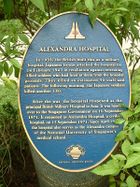معركة سنغافورة
| معركة سنغافورة Battle of Singapore | |||||||
|---|---|---|---|---|---|---|---|
| جزء من حرب المحيط الهادي والحرب العالمية الثانية | |||||||
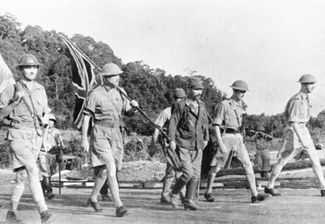 Lieutenant-General Arthur Percival, led by a Japanese officer, walks under a flag of truce to negotiate the capitulation of Allied forces in Singapore, on 15 February 1942. It was the largest surrender of British-led forces in history. | |||||||
| |||||||
| المتحاربون | |||||||
|
|
| ||||||
| القادة والزعماء | |||||||
|
|
| ||||||
| الوحدات المشاركة | |||||||
|
| ||||||
| القوى | |||||||
| 85,000 | 36,000 | ||||||
| الضحايا والخسائر | |||||||
|
85,000 5,000 killed or wounded 80,000 captured |
4,485 1,713 killed 2,772 wounded[2] | ||||||
معركة سنغافورة، وتُعرف أيضاً بإسم سقوط سنغافورة، نشبت في مسرح عمليات جنوب شرق آسيا في الحرب العالمية الثانية حين غزت امبراطورية اليابان معقل الحلفاء الحصين، سنغافورة. وكانت سنغافورة هي أكبر وأقوى قاعدة عسكرية بريطانية في جنوب شرق آسيا وكانت تـُكنـّى "جبل طارق الشرق". استمر القتال في سنغافورة في الفترة 8–15 فبراير 1942.
It resulted in the capture of Singapore by the Japanese and the largest surrender of British-led military personnel in history.[2] About 80,000 British, Indian and Australian troops became prisoners of war, joining 50,000 taken by the Japanese in the earlier Malayan Campaign. British Prime Minister Winston Churchill called the ignominious fall of Singapore to the Japanese the "worst disaster" and "largest capitulation" in British military history.[3]
خلفية
اندلاع الحرب
The Allies had imposed a trade embargo on Japan in response to its continued campaigns in China. Seeking alternative sources of necessary materials for its Pacific War against the Allies, Japan invaded Malaya.[4] Singapore — to the south — was connected to Malaya by the Johor–Singapore Causeway. The Japanese saw it as a port which could be used as a launching pad against other Allied interests in the area and to consolidate the invaded territory.
غزو الملايو
 
|
|---|
| هذه المقالة جزء من سلسلة تاريخ سنغافورة |
| التاريخ المبكر لسنغافورة (قبل 1819) |
| تأسيس سنغافورة الحديثة (1819–1826) |
| مستوطنات المضائق (1826–1867) |
| مستعمرة التاج (1867–1942) |
| معركة سنغافورة (1942) |
| الاحتلال الياباني (1942–1945) |
| مذبحة سوك تشينگ (1942–1945) |
| فترة ما بعد الحرب (1945–1955) |
| المجلس التشريعي الأول (1948–1951) |
| اضطرابات ماريا هرتوگ(1950) |
| المجلس التشريعي الثاني (1951–1955) |
| Anti-National Service Riots (1954) |
| الحكم الذاتي الداخلي (1955–1962) |
| اضطرابات حافلات هوك لي (1955) |
| الاندماج في ماليزيا (1962–1965) |
| استفتاء الاندماج (1962) |
| العملية كولدستور (1963) |
| الاضطرابات العرقية في سنغافورة (1964) |
| MacDonald House bombing (1965) |
| جمهورية سنغافورة (1965–الحاضر) |
| الاضطرابات العرقية في سنغافورة (1969) |
| العملية سپكترم (1987) |
| الأزمة المالية في شرق آسيا (1997) |
| مخطط مهاجمة السفارات (2001) |
| تفشي السارز (2003) |
| مخطط زمني لتاريخ سنغافورة |
The Japanese 25th Army invaded from Indochina, moving into northern Malaya and تايلند by amphibious assault on 8 December 1941.[5] This was virtually simultaneous with the Japanese attack on Pearl Harbor, which was meant to deter the US from intervening in Southeast Asia. Thailand initially resisted, but soon had to yield and allow the Japanese use their military bases to invade the European colonies in Southeast Asia. The Japanese then proceeded overland across the Thai–Malayan border to attack Malaya. At this time, the Japanese began bombing strategic sites in Singapore, and air raids were conducted on Singapore from 29 December onwards.
التمهيد
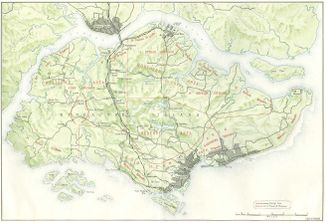
المعركة
الابرار الياباني
الحرب الجوية
مذبحة مستشفى ألكسندرا
سقوط سنغافورة
التبعات
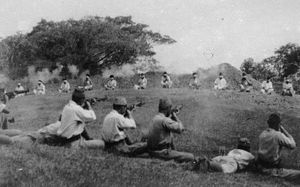
انظر أيضاً
- قيادة الملايو
- قيادة الشرق الأقصى البريطانية
- Japanese order of battle during the Malayan Campaign
- British Military Hospital, Singapore
ملاحظات
الهامش
- ^ L, Klemen (1999–2000). "Rear-Admiral Shoji Nishimura". Forgotten Campaign: The Dutch East Indies Campaign 1941–1942.
- ^ أ ب Smith, Colin (2006). Singapore Burning: Heroism and Surrender in World War II. Penguin Group. ISBN 0-14-101036-3.
- ^ Churchill, Winston (1986). The Hinge of Fate, Volume 4
- ^ Thompson, p. 92–94.
- ^ L, Klemen (1999–2000). "Seventy minutes before Pearl Harbor – The landing at Kota Bharu, Malaya, on December 7th 1941". Forgotten Campaign: The Dutch East Indies Campaign 1941–1942.
{{cite web}}: Unknown parameter|coauthors=ignored (|author=suggested) (help)
المراجع
- Cull, Brian (2004). Hurricanes Over Singapore: RAF, RNZAF and NEI Fighters in Action Against the Japanese Over the Island and the Netherlands East Indies, 1942. Grub Street Publishing. ISBN 978-1-904010-80-7.
- Cull, Brian (2008). Buffaloes over Singapore: RAF, RAAF, RNZAF and Dutch Brewster Fighters in Action Over Malaya and the East Indies 1941–1942. Grub Street Publishing. ISBN 978-1-904010-32-6.
- Dixon, Norman F. On the Psychology of Military Incompetence, London, 1976
- Bose, Romen. SECRETS OF THE BATTLEBOX: The History and Role of Britain's Command HQ during the Malayan Campaign, Marshall Cavendish, Singapore 2005
- Bose, Romen. KRANJI:The Commonwealth War Cemetery and the Politics of the Dead, Singapore: Marshall Cavendish (2006)
- Elphick, Peter, Singapore, the pregnable fortress, Hodder & Stoughton, London, 1995, ISBN 0-340-64990-9
- Kelly, Terence (2008). Hurricanes Versus Zeros: Air Battles over Singapore, Sumatra and Java. Pen and Sword. ISBN 978-1-84415-622-1.
- Kinvig, Clifford. Scapegoat: General Percival of Singapore, London (1996) ISBN 0-241-10583-8
- Leasor, James. Singapore: The Battle That Changed The World UK, USA 1968, 2011. ISBN 978-1-908291-18-9
- Percival, Lieutenant-General A.E. (1946). Operations of Malaya Command from 5th December 1941 to 15th February 1942. London: UK Secretary of State for War. (Percival's despatches published in London Gazette: (Supplement) no. 38215, pp. 1245–1346, 20 February 1948. Retrieved on 16 August 2012.)
- Seki, Eiji. Mrs. Ferguson's Tea-Set, Japan and the Second World War: The Global Consequences Following Germany's Sinking of the SS Automedon in 1940. London: Global Oriental (2006) ISBN 1-905246-28-5; (cloth) [reprinted by University of Hawaii Press, Honolulu, 2007 – previously announced as Sinking of the SS Automedon and the Role of the Japanese Navy: A New Interpretation.]
- Shores, Christopher F; Cull, Brian; Izawa, Yasuho. Bloody Shambles: The First Comprehensive Account of the Air Operations over South-East Asia December 1941 – April 1942, London: Grub Street (2007)
- Shores, Christopher F; Cull, Brian; Izawa, Yasuho. Bloody Shambles, The First Comprehensive Account of the Air Operations over South-East Asia December 1941 – April 1942 Volume One: Drift to War to the Fall of Singapore. London: Grub Street Press. (1992) ISBN 0-948817-50-X
- Smith, Colin. Singapore Burning: Heroism and Surrender in World War II Penguin (2005) ISBN 0-670-91341-3
- Smyth, John George, Percival and the Tragedy of Singapore, MacDonald and Company, 1971
- Thompson, P. The Battle for Singapore, The True Story of the Greatest Catastrophe of World War II, London (2006) ISBN 0-7499-5099-4
وصلات خارجية
| مراجع مكتبية عن معركة سنغافورة |
- National Heritage Board, Battlefield Singapore
- Bicycle Blitzkrieg – The Japanese Conquest of Malaya and Singapore 1941–1942
- Royal Engineers Museum Royal Engineers and the Second World War – the Far East
- The diary of one British POW, Frederick George Pye of the Royal Engineers. Fred Pye was a POW for 3½ years, including time spent building the Burma Railway. He managed to save, write on and bury scraps of paper, and after the war compiled them into a readable form.
- Animated History of the Fall of Malaya and Singapore
- Pages using gadget WikiMiniAtlas
- CS1 errors: unsupported parameter
- Coordinates on Wikidata
- Articles with hatnote templates targeting a nonexistent page
- نزاعات 1942
- 1942 في سنغافورة
- الحكم البريطاني في سنغافورة
- عمليات ومعارك الحرب العالمية الثانية في مسرح جنوب شرق آسيا
- Battles of World War II involving Australia
- معارك الحرب العالمية الثانية التي شاركت فيها الهند
- Battles of World War II involving Japan
- معارك الحرب العالمية الثانية التي شاركت فيها المملكة المتحدة
- عسكرية سنغافورة تحت الحكم البريطاني
- التاريخ العسكري لسنغافورة
- Military history of Singapore during World War II
- Military history of India during World War II
- Indian National Army
- العلاقات السنغافورية اليابانية
